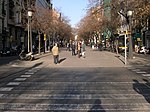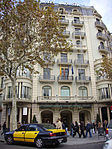Provença–Diagonal station
Avinguda DiagonalBarcelona Metro line 3 stationsBarcelona Metro line 5 stationsBarcelona Metro line 6 stationsBarcelona Metro line 7 stations ... and 6 more
Railway stations located underground in SpainRailway stations opened in 1882Railway stations opened in 1924Railway stations opened in 1969Stations on the Barcelona–Vallès LineTransport in Eixample

Provença is the name of a Ferrocarrils de la Generalitat de Catalunya station located under Avinguda Diagonal and Balmes street. The station is served by FGC-operated Barcelona Metro lines L6 and L7, and Metro del Vallès suburban metro lines S1, S2, S5 and S55. Diagonal is the name of an important station in TMB-operated Barcelona Metro network. It is named after Avinguda Diagonal, where the station is located together with Passeig de Gràcia. It is served by TMB-operated Barcelona Metro lines L3 and L5, and it is also connected with FGC station.
Excerpt from the Wikipedia article Provença–Diagonal station (License: CC BY-SA 3.0, Authors, Images).Provença–Diagonal station
Carrer del Rosselló, Barcelona
Geographical coordinates (GPS) Address Nearby Places Show on map
Geographical coordinates (GPS)
| Latitude | Longitude |
|---|---|
| N 41.394722222222 ° | E 2.1597222222222 ° |
Address
Carrer del Rosselló 222
08001 Barcelona
Catalonia, Spain
Open on Google Maps









